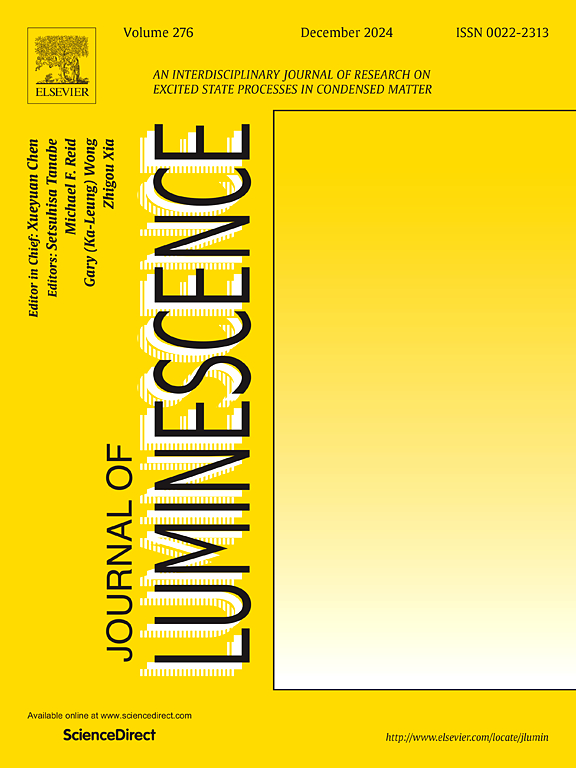探索Eu3+活化的LaOBr纳米荧光粉的结构和发光特性,用于潜在的照明,光学测温和法医应用
IF 3.3
3区 物理与天体物理
Q2 OPTICS
引用次数: 0
摘要
红发荧光粉的里程碑意义是通过固态途径合成高亮度的LaOBr: Eu3+纳米荧光粉。利用x射线衍射(XRD)和Rietveld细化分析对其进行了全面的相纯度和晶体结构表征。利用x射线光子电子能谱(XPS)、透射电镜(TEM)、透射电镜(FESEM)和能谱仪(EDS)等技术证实了Eu3+在LaOBr基体中的元素组成、形态和掺入情况。利用Judd-Ofelt分析评价了其辐射特性,JO参数遵循趋势Ω2 >;4Ω。光致发光光谱在618 nm处显示出深红色发射,通过偶极子-偶极子相互作用确定样品在5 mol%时为最佳浓度。发现衰变寿命为微秒级,量热研究给出了最佳浓度的CIE坐标(0.6304,0.3692),CCT (1186 K)和LER (182 lm/W)。优化后的荧光粉具有良好的热稳定性和活化能。利用FIR和FWHM模式计算了优化后的荧光粉材料的绝对和相对灵敏度。令人印象深刻的是,这些纳米荧光粉的范围被用于检测潜在指纹(LFP),唇印以及制造具有优异灵敏度和分辨率的柔性发光油墨。这项研究展示了LaOBr: Eu3+作为一个多功能发光平台,应用于wled,光学测温,法医科学,柔性显示和防伪。本文章由计算机程序翻译,如有差异,请以英文原文为准。
Exploring the structural and luminescent properties of Eu3+ activated LaOBr nanophosphors for potential lighting, optical thermometry and forensic applications
The milestone significance of red-emitting phosphor has channeled the synthesis of high-luminous LaOBr: Eu3+ nanophosphors through a solid-state route. The comprehensive phase purity and crystal structure characterizations are performed using X-ray diffraction (XRD) and Rietveld refinement analysis. The elemental composition, morphology and the incorporation of Eu3+ in LaOBr matrix are substantiated using X-ray photon electron spectroscopy (XPS), TEM, FESEM and EDS techniques. The radiative properties were evaluated using Judd-Ofelt analysis, and the JO parameters follow the trend Ω2 > Ω4. The photoluminescence spectrum exhibits deep red emission at 618 nm and the sample at 5 mol% is determined to be the optimized concentration, through dipole-dipole interaction. The decay lifetime is found to be the order of microseconds and the calorimetric investigation, gives insights about CIE coordinates (0.6304, 0.3692), CCT (1186 K) and LER (182 lm/W) of the optimum concentration. The optimized phosphor exhibited good thermal stability and activation energy is evaluated. The FIR and FWHM modes are utilized to calculate the absolute and relative sensitivities of the optimized phosphor material. Impressively, the scope of these nanophosphors was leveraged to detect latent fingerprints (LFP), lip prints and for the fabrication of flexible luminescent inks with excellent sensitivity and resolution. This study showcases LaOBr: Eu3+ as a versatile luminous platform for applications in WLEDs, optical thermometry, forensic science, flexible displays and anti-counterfeiting.
求助全文
通过发布文献求助,成功后即可免费获取论文全文。
去求助
来源期刊

Journal of Luminescence
物理-光学
CiteScore
6.70
自引率
13.90%
发文量
850
审稿时长
3.8 months
期刊介绍:
The purpose of the Journal of Luminescence is to provide a means of communication between scientists in different disciplines who share a common interest in the electronic excited states of molecular, ionic and covalent systems, whether crystalline, amorphous, or liquid.
We invite original papers and reviews on such subjects as: exciton and polariton dynamics, dynamics of localized excited states, energy and charge transport in ordered and disordered systems, radiative and non-radiative recombination, relaxation processes, vibronic interactions in electronic excited states, photochemistry in condensed systems, excited state resonance, double resonance, spin dynamics, selective excitation spectroscopy, hole burning, coherent processes in excited states, (e.g. coherent optical transients, photon echoes, transient gratings), multiphoton processes, optical bistability, photochromism, and new techniques for the study of excited states. This list is not intended to be exhaustive. Papers in the traditional areas of optical spectroscopy (absorption, MCD, luminescence, Raman scattering) are welcome. Papers on applications (phosphors, scintillators, electro- and cathodo-luminescence, radiography, bioimaging, solar energy, energy conversion, etc.) are also welcome if they present results of scientific, rather than only technological interest. However, papers containing purely theoretical results, not related to phenomena in the excited states, as well as papers using luminescence spectroscopy to perform routine analytical chemistry or biochemistry procedures, are outside the scope of the journal. Some exceptions will be possible at the discretion of the editors.
 求助内容:
求助内容: 应助结果提醒方式:
应助结果提醒方式:


